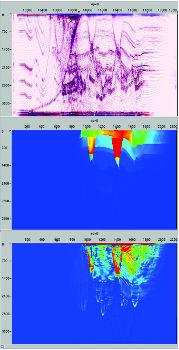An Imaging Note and the BP 2.5 Dimensional Data
Before providing some comparisons of one- and two-way migrations on complex data sets, it is worth discussing imaging data sets that, because of severe illumination or surface issues, might have wide ranging differences in both source generated and receiver suppressed energy levels. This issue was brought to light by several researchers at AMOCO and later BP. J. T. Etgen, Carl Regone and colleagues generated the model, which, when migrated, produced such a wide range of output reflection strengths that just displaying it was difficult.
Figure 5 shows how this reflection strength disparage can be overcome by a careful compensation for illumination. The bottom part of this figure shows a straightforward migration of the original input data. The middle part represents the illumination in space and depth. Simply dividing by this quantity produces the image at the top of Figure 5. Note that this process is not equivalent to an automatic gain control. It is actually based on being able to correctly handle energy differences specified by the Earth model and correct the output image for lateral and vertical differences.
- Introduction
- Seismic Modeling
- History
- Zero Offset Migration Algorithms
- Exploding Reflector Examples
- Prestack Migration
- Prestack Migration Examples
- Common Azimuth on the SEG/EAGE C3-NA Synthetic
- Kirchhoff versus One-Way on a Gulf of Mexico 2D Salt Synthetic
- A North Sea Sill Synthetic
- Marmousi Case Study
- An Imaging Note and the BP 2.5 Dimensional Data
- BP 2.5 D Data
- BP 2004 Salt Structure Data
- SEG AA' Data Set
- Migration from Topography
- The SMAART JV Sigsbee Model
- SMAART JV Pluto Data Set
- SEG/EAGE C3-NA Data Imaging
- Anisotropic Earth Models
- Data Acquisition
- Migration Summary
- Isotropic Velocity Analysis
- Anisotropic Velocity Analysis
- Case Studies
- Course Summary

